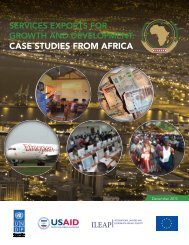BUDGET
budget
budget
Create successful ePaper yourself
Turn your PDF publications into a flip-book with our unique Google optimized e-Paper software.
88 A GOVERNMENT OF THE FUTURE<br />
President’s Management Agenda, focusing on<br />
four key areas: delivering smarter information<br />
technology (IT); strengthening Federal cybersecurity;<br />
delivering world-class customer service;<br />
and reshaping engagement with communities<br />
and citizens.<br />
Delivering Smarter IT<br />
The Administration has embarked on a comprehensive<br />
effort to fundamentally improve<br />
the way that the Government delivers technology<br />
services to the public, called the Smarter<br />
IT Delivery Agenda. The Agenda is focused on<br />
recruiting top technologists and entrepreneurs<br />
to work within agencies on the highest priority<br />
projects, leveraging the best processes to increase<br />
oversight and accountability for IT spending,<br />
and ramping up Government contracting with<br />
innovative companies. To date, these and other<br />
efforts have saved over $3.5 billion.<br />
Recruiting the Best Talent. A key component<br />
of the Smarter IT delivery strategy is<br />
recruiting the best talent to work as part of,<br />
and with, the Federal Government. In 2014,<br />
the Administration piloted the U.S. Digital<br />
Service (USDS)—a group of select private-sector<br />
innovators, entrepreneurs, and engineers<br />
recruited to Government service to improve and<br />
simplify the digital experience between individuals,<br />
businesses, and the Government. Digital<br />
Service experts have worked in collaboration<br />
with Federal agencies to implement streamlined<br />
and effective digital technology practices on the<br />
Nation’s highest priority programs. The team<br />
has also worked to disseminate best practices<br />
such as the U.S. Web Design Standards, an open<br />
source visual style guide to create consistent<br />
and superb user experiences across U.S. Federal<br />
Government websites.<br />
USDS teams have also reimagined how<br />
Government services should be provided to the<br />
public. The USDS supported the United States<br />
Citizenship and Immigration Services (USCIS)<br />
transition to electronic filing and processing of<br />
Form I-90 to renew, or replace, a green card and<br />
the Immigrant Visa Fee payment. Closing down<br />
the old Electronic Immigration System will<br />
save the agency millions of dollars per year in<br />
ongoing operations, maintenance, and licensing<br />
costs, and the newly launched myUSCIS makes<br />
it easier for users to access information about<br />
the immigration process and immigration services.<br />
USDS supported HealthCare.gov during<br />
the 2015 open enrollment season, and worked<br />
between open enrollment seasons to dramatically<br />
improve site performance and save millions of<br />
dollars per year in operating expenses. In addition,<br />
USDS launched the new College Scorecard<br />
with the Department of Education to give students,<br />
parents, and their advisors the clearest,<br />
most accessible, and most reliable national data<br />
on college cost, graduation, debt, and post-college<br />
earnings. This new College Scorecard provides<br />
students and families with information on college<br />
performance that can help them identify colleges<br />
that are serving students of all backgrounds well<br />
and providing a quality and affordable education.<br />
It empowers Americans to search for colleges<br />
based on what matters most to them and allows<br />
them to compare the value offered by different<br />
colleges to help improve their decision. Within<br />
the first month, the College Scorecard had over<br />
one million users, more than 10 times the users<br />
its predecessor had in a year. Over a dozen other<br />
organizations have used the Scorecard data<br />
to launch new tools to support students in their<br />
college search and application processes.<br />
To facilitate requests for short-term support,<br />
USDS created a new Rapid Response team in<br />
2015. This team’s work included restoring service<br />
for the Department of State’s Consolidated<br />
Consular Database, after an outage led to a twoweek<br />
suspension of visa issuances worldwide. In<br />
2016, the USDS is partnering with the Internal<br />
Revenue Service (IRS) to bolster electronic authentication<br />
procedures, laying the groundwork<br />
for unified and secure taxpayer access to all IRS<br />
digital services.<br />
To institutionalize the dramatic improvements<br />
that this approach has demonstrated, the<br />
Budget funds the development of digital services<br />
teams at 25 agencies. These small, high-impact<br />
teams will drive the quality and effectiveness




